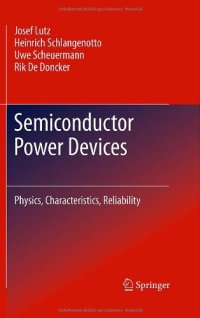
Ebook: Semiconductor Power Devices: Physics, Characteristics, Reliability
- Genre: Mathematics // Mathematicsematical Physics
- Tags: Electronics and Microelectronics Instrumentation, Power Electronics Electrical Machines and Networks, Condensed Matter Physics
- Year: 2011
- Publisher: Springer-Verlag Berlin Heidelberg
- Edition: 1
- Language: English
- pdf
Semiconductor power devices are the heart of power electronics. They determine the performance of power converters and allow topologies with high efficiency. Semiconductor properties, pn-junctions and the physical phenomena for understanding power devices are discussed in depth. Working principles of state-of-the-art power diodes, thyristors, MOSFETs and IGBTs are explained in detail, as well as key aspects of semiconductor device production technology. In practice, not only the semiconductor, but also the thermal and mechanical properties of packaging and interconnection technologies are essential to predict device behavior in circuits. Wear and aging mechanisms are identified and reliability analyses principles are developed. Unique information on destructive mechanisms, including typical failure pictures, allows assessment of the ruggedness of power devices. Also parasitic effects, such as device induced electromagnetic interference problems, are addressed. The book concludes with modern power electronic system integration techniques and trends.
Semiconductor power devices are the heart of power electronics. They determine the performance of power converters and allow topologies with high efficiency. Semiconductor properties, pn-junctions and the physical phenomena for understanding power devices are discussed in depth. Working principles of state-of-the-art power diodes, thyristors, MOSFETs and IGBTs are explained in detail, as well as key aspects of semiconductor device production technology. In practice, not only the semiconductor, but also the thermal and mechanical properties of packaging and interconnection technologies are essential to predict device behavior in circuits. Wear and aging mechanisms are identified and reliability analyses principles are developed. Unique information on destructive mechanisms, including typical failure pictures, allows assessment of the ruggedness of power devices. Also parasitic effects, such as device induced electromagnetic interference problems, are addressed. The book concludes with modern power electronic system integration techniques and trends.